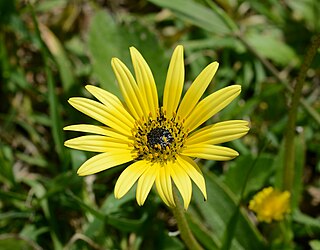
The Polygonaceae are a family of flowering plants known informally as the knotweed family or smartweed—buckwheat family in the United States. The name is based on the genus Polygonum, and was first used by Antoine Laurent de Jussieu in 1789 in his book, Genera Plantarum. The name may refer to the many swollen nodes the stems of some species have, being derived from Greek [poly meaning 'many' and gony meaning 'knee' or 'joint']. Alternatively, it may have a different origin, meaning 'many seeds'.

Trillium is a genus of about fifty flowering plant species in the family Melanthiaceae. Trillium species are native to temperate regions of North America and Asia, with the greatest diversity of species found in the southern Appalachian Mountains in the southeastern United States.

Arctotis is a genus of annual and perennial plants in the family Asteraceae.

Polygonum is a genus of about 130 species of flowering plants in the buckwheat and knotweed family Polygonaceae. Common names include knotweed and knotgrass. In the Middle English glossary of herbs Alphita, it was known as ars-smerte. There have been various opinions about how broadly the genus should be defined. For example, buckwheat has sometimes been included in the genus as Polygonum fagopyrum. Former genera such as Polygonella have been subsumed into Polygonum; other genera have been split off.

Persicaria maculosa is an annual plant in the buckwheat family, Polygonaceae. Common names include lady's thumb, spotted lady's thumb, Jesusplant, and redshank. It is widespread across Eurasia from Iceland south to Portugal and east to Japan. It is also present as an introduced and invasive species in North America, where it was first noted in the Great Lakes region in 1843 and has now spread through most of the continent.

Fallopia is a genus of about 12 species of flowering plants in the buckwheat family, often included in a wider treatment of the related genus Polygonum in the past, and previously including Reynoutria. The genus is native to temperate and subtropical regions of the Northern Hemisphere, but species have been introduced elsewhere. The genus includes species forming vines and shrubs.

Atraphaxis is a genus of flowering plants in the family Polygonaceae with about 40 species.

Polygonum dentoceras is a rare species of flowering plant in the knotweed family known by the common names sandlace, woody wireweed, and Small's jointweed. It is endemic to Florida in the United States, where it is limited to the central ridges of the peninsula, including the Lake Wales Ridge. It is threatened by the loss and degradation of its habitat. It is a federally listed endangered species of the United States.
Polygonum smallianum is a species of flowering plant in the knotweed family known by the common name largeleaf jointweed. It is native to a small area around the border between Alabama and Florida in the United States.
Polygonum delopyrum, the fringed jointweed or hairy jointweed, is a plant species endemic to Florida. It is found in pinelands and sandy pine barrens at elevations less than 50 m, in central and southern parts of the state.

Polygonum serotinum, commonly called southern jointweed or American jointweed, is a species of flowering plant in the knotweed family. It is native to Southeastern United States extending in scattered locations west to New Mexico. Its preferred habitat is dry, sandy areas.
Polygonum agreste is a species of flowering plant in the family Polygonaceae, native to Uzbekistan. It was first described by Georgji Sumnevicz in 1940.
Polygonum heterophyllumSol. ex Meisn. is a species of flowering plant in the family Polygonaceae, native to Uzbekistan, Turkmenistan and Tajikistan. It was first described by Daniel Solander in 1856.
Polygonum polyneuron is a species of flowering plant in the family Polygonaceae, native to Japan, Korea, the Kuril Islands, and Primorye. It was first described by Adrien René Franchet & Ludovic Savatier.
Polygonum exsertum is a species of flowering plant in the family Polygonaceae, native to Illinois. It was first described by John Kunkel Small in 1894.
Polygonum deciduum is a species of flowering plant in the family Polygonaceae, native to Uzbekistan. It was first described in 1856.

Hypericum undulatum, the wavy St Johns Wort, is a herbaceous perennial flowering plant native to western Europe and northern Africa. The specific name undulatum is Latin, meaning "wavy" or "undulated", referring, just as the common name, to the wavy leaf margins of the herb. The plant has a diploid number of 16 or 32.

Polygonoideae is a subfamily of plants in the family Polygonaceae. It includes a number of plants that can be highly invasive, such as Japanese knotweed, Reynoutria japonica, and its hybrid with R. sachalinensis, R. × bohemica. Boundaries between the genera placed in the subfamily and their relationships have long been problematic, but a series of molecular phylogenetic studies have clarified some of them, resulting in the division of the subfamily into seven tribes.

Duma is a genus of shrubby flowering plants in the family Polygonaceae, subfamily Polygonoideae. The genus was separated from Muehlenbeckia in 2011. The native range of the genus is Australia.











